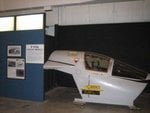The B1 has a crew capsule for ejection.
The Vulcan and Victor only had ejection seats for the pilot and co-pilot:
From wiki:
>>Although the Vulcan had a crew of up to seven, only the pilot and co-pilot were provided with ejector seats. This feature of the Vulcan has been the basis of significant criticism; there were instances of the pilot and co-pilot ejecting in an emergency leaving their colleagues to face death. The navigator plotter, navigator radar and electronics operator could only escape by leaving their seats and escaping out of the cockpit via the entrance door before the pilots had ejected. Their parachutes were opened automatically by static line. This door was situated underneath immediately forward of the front undercarriage and would have been a very tricky exercise if the latter was down at the time. The method of escape was practised regularly, and successfully put into action on more than one occasion, with all crew members surviving, but relied on the absence of g-forces which in other cases made it impossible.<<
Are there any other interesting means of escape or bomber ejection seat stories?
The Vulcan and Victor only had ejection seats for the pilot and co-pilot:
From wiki:
>>Although the Vulcan had a crew of up to seven, only the pilot and co-pilot were provided with ejector seats. This feature of the Vulcan has been the basis of significant criticism; there were instances of the pilot and co-pilot ejecting in an emergency leaving their colleagues to face death. The navigator plotter, navigator radar and electronics operator could only escape by leaving their seats and escaping out of the cockpit via the entrance door before the pilots had ejected. Their parachutes were opened automatically by static line. This door was situated underneath immediately forward of the front undercarriage and would have been a very tricky exercise if the latter was down at the time. The method of escape was practised regularly, and successfully put into action on more than one occasion, with all crew members surviving, but relied on the absence of g-forces which in other cases made it impossible.<<
Are there any other interesting means of escape or bomber ejection seat stories?



